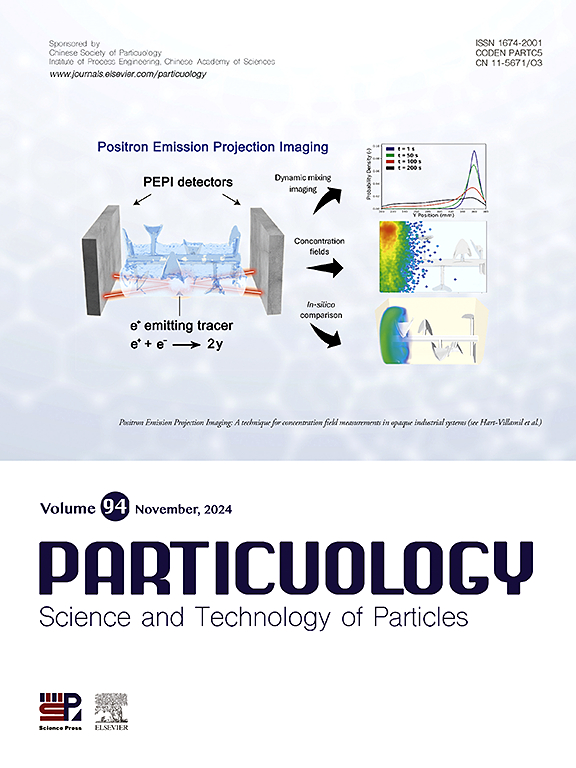Effect of continuous single bubble injection on binary mixtures in a fluidized bed
IF 4.1
2区 材料科学
Q2 ENGINEERING, CHEMICAL
引用次数: 0
Abstract
In this study, single bubbles are injected into a binary mixture comprising both spherical and rod-like particles to explore bubble shape and diameter. Effect of continuously injecting bubbles into a fluidized bed at a velocity near the minimum fluidization velocity on mixing is investigated. The combination of computational fluid dynamics and discrete element methods (CFD-DEM) as well as an experimental setup were used to investigate the mixing of particles in this situation. The rod-like particles were modeled by multi-sphere method. To assess the mixing performance, both qualitative and quantitative measures were employed, including visual examination of fluidized beds and evaluating subdomain-based mixing index. It was shown that the continuous injection of single bubbles can significantly improve mixing compared with the case of no bubble injection. Furthermore, when the number of rod-like particles increases, the continuous injection of single bubbles is an effective technique for improving mixing. In processes where gas utilization is critical and cost optimization is paramount, continuous injection of bubbles can reduce the gas volume required. This method is particularly beneficial in industries where high gas volumes are impractical or require significant equipment changes. It also helps break down dead zones and channeling phenomena in fluidized beds, especially when rod-like particles are present.

求助全文
约1分钟内获得全文
求助全文
来源期刊

Particuology
工程技术-材料科学:综合
CiteScore
6.70
自引率
2.90%
发文量
1730
审稿时长
32 days
期刊介绍:
The word ‘particuology’ was coined to parallel the discipline for the science and technology of particles.
Particuology is an interdisciplinary journal that publishes frontier research articles and critical reviews on the discovery, formulation and engineering of particulate materials, processes and systems. It especially welcomes contributions utilising advanced theoretical, modelling and measurement methods to enable the discovery and creation of new particulate materials, and the manufacturing of functional particulate-based products, such as sensors.
Papers are handled by Thematic Editors who oversee contributions from specific subject fields. These fields are classified into: Particle Synthesis and Modification; Particle Characterization and Measurement; Granular Systems and Bulk Solids Technology; Fluidization and Particle-Fluid Systems; Aerosols; and Applications of Particle Technology.
Key topics concerning the creation and processing of particulates include:
-Modelling and simulation of particle formation, collective behaviour of particles and systems for particle production over a broad spectrum of length scales
-Mining of experimental data for particle synthesis and surface properties to facilitate the creation of new materials and processes
-Particle design and preparation including controlled response and sensing functionalities in formation, delivery systems and biological systems, etc.
-Experimental and computational methods for visualization and analysis of particulate system.
These topics are broadly relevant to the production of materials, pharmaceuticals and food, and to the conversion of energy resources to fuels and protection of the environment.
 求助内容:
求助内容: 应助结果提醒方式:
应助结果提醒方式:


